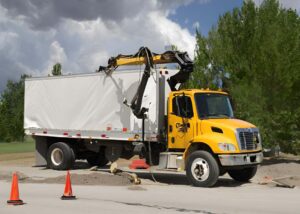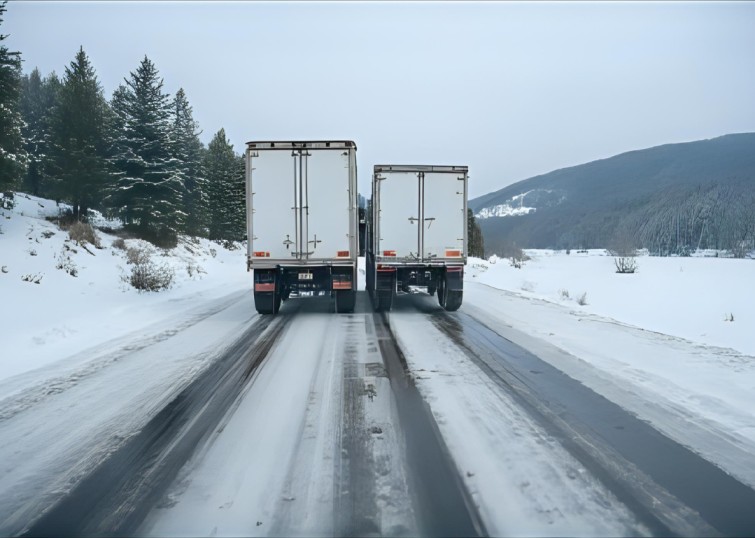TL;DR
OSHA violations in the construction industry significantly contribute to truck accidents, leading to increased injuries, fatalities, and financial losses. Non-compliance with safety standards results in unsafe working conditions, inadequate training, and poor equipment maintenance. Addressing these violations through stricter enforcement and better safety practices can reduce the frequency and severity of accidents on construction sites.
Key Highlights
- Higher Accident Rates: OSHA violations correlate with a rise in construction truck accidents.
- Common Violations: Inadequate training, improper equipment maintenance, and lack of safety protocols.
- Consequences: Increased injuries, fatalities, legal penalties, and financial losses.
- Prevention Strategies: Enhanced training programs, regular safety inspections, and strict adherence to OSHA standards.
- Economic Impact: Costs related to accidents include medical expenses, legal fees, and project delays.
- Regulatory Enforcement: Strengthening OSHA enforcement can lead to safer construction environments.

Construction sites are inherently risky environments where heavy machinery and large vehicles like trucks operate in close proximity to workers. According to the Bureau of Labor Statistics, construction-related fatalities accounted for 20% of all workplace deaths in the United States in 2022. Truck accidents within this sector are a major contributor to these statistics, posing significant dangers to both drivers and on-site personnel.
In Georgia, specific regulations under the Occupational Safety and Health Administration (OSHA) aim to mitigate these risks by setting standards for vehicle operation, worker safety, and site management. For example, Georgia’s state plan OSHA guidelines emphasize the importance of proper training for truck operators and the routine maintenance of construction vehicles to prevent malfunctions that could lead to accidents.
Understanding the role of OSHA violations in construction truck accidents is crucial for improving safety measures. By examining the common infractions and their direct impact on site safety, stakeholders can implement more effective strategies to protect workers and reduce the incidence of accidents.
Common OSHA Violations Leading to Truck Accidents
OSHA sets forth numerous standards to ensure safety on construction sites, particularly concerning the operation of trucks and heavy machinery. Violations of these standards can create hazardous conditions that increase the likelihood of accidents. Some of the most common OSHA violations that contribute to truck accidents include:
Insufficient Driver Training
OSHA mandates comprehensive training programs for all truck operators to ensure they understand safe driving practices, vehicle handling, and emergency procedures. When companies fail to provide adequate training, drivers may lack the necessary skills to navigate construction sites safely, leading to accidents.
Poor Equipment Maintenance
Regular maintenance of trucks and construction vehicles is essential to prevent mechanical failures. OSHA requires that all equipment be kept in good working condition, with routine inspections and timely repairs. Neglecting maintenance can result in brake failures, tire blowouts, and other mechanical issues that are direct causes of accidents.
Inadequate Safety Protocols
Safety protocols, including the use of seat belts, proper load securing, and adherence to speed limits, are critical in preventing accidents. OSHA violations often include the absence of these protocols or the failure to enforce them, creating an unsafe environment for both drivers and workers.
Hazardous Worksite Conditions
OSHA standards address various worksite conditions such as proper lighting, clear signage, and safe traffic management. Violations in these areas, like poor visibility or lack of traffic control measures, can lead to collisions between trucks and other vehicles or workers on site.
Lack of Personal Protective Equipment (PPE)
While PPE is more directly related to worker safety, its absence can indirectly contribute to truck accidents. For example, workers without high-visibility clothing are harder for truck operators to see, increasing the risk of accidents.
Failure to Conduct Risk Assessments
OSHA requires regular risk assessments to identify potential hazards on construction sites. Failure to perform these assessments can result in unaddressed risks that may lead to accidents, including those involving construction trucks.
Consequences of OSHA Violations in Construction Truck Accidents
OSHA violations in construction not only jeopardize worker safety but also have broader implications for companies and the industry as a whole. The consequences of these violations can be severe and multifaceted.
Increase in Injuries and Fatalities
The most immediate impact of OSHA violations is the rise in workplace injuries and fatalities. Construction truck accidents can result in serious injuries such as broken bones, traumatic brain injuries, and even death. These outcomes can devastate families and communities while highlighting the critical need for safety compliance.
Legal and Financial Repercussions
Companies that violate OSHA standards may face substantial fines and legal actions. OSHA penalties can be hefty, especially for repeat offenders, and legal battles stemming from accidents can lead to significant financial losses. Additionally, companies may incur costs related to workers’ compensation claims and increased insurance premiums.
Project Delays and Increased Costs
Accidents can cause significant delays in construction projects, leading to missed deadlines and increased costs. Equipment repairs, site shutdowns, and the need to replace injured workers can all contribute to budget overruns and extended project timelines.
Damage to Reputation
Safety violations and resultant accidents can tarnish a company’s reputation. Negative publicity and a history of non-compliance can make it difficult to attract new clients and retain existing ones, ultimately affecting the company’s long-term success.
Loss of Productivity
Workplace accidents lead to a loss of productivity as injured workers are unable to perform their duties. Additionally, the time and resources required to investigate accidents and implement corrective measures can further reduce overall productivity on construction sites.
Economic Impact of Construction Truck Accidents Due to OSHA Violations
The economic burden of construction truck accidents resulting from OSHA violations extends beyond the immediate costs associated with accidents. These incidents have far-reaching financial implications for businesses, the economy, and society at large.
Direct Costs
Direct costs include medical expenses for injured workers, legal fees from truck accidents lawsuits, and fines imposed by OSHA for violations. These costs can be substantial, especially in severe accidents involving multiple injuries or fatalities. For smaller construction firms, even a single accident can have a crippling financial impact.
Indirect Costs
Indirect costs are often more significant and include lost productivity, training replacement workers, and the administrative burden of managing accident aftermaths. Additionally, there is the cost of damaged equipment and project delays, which can lead to contractual penalties and the need for additional funding.
Insurance Premiums
Frequent accidents and a poor safety record can lead to higher insurance premiums for construction companies. Insurance providers view these companies as high-risk, resulting in increased costs for liability and workers’ compensation coverage, which can strain company finances.
Impact on Workforce
Accidents can lead to a decrease in workforce morale and trust. Workers who feel unsafe are less likely to remain with a company, leading to higher turnover rates and the associated costs of recruiting and training new employees. Moreover, a reputation for poor safety can make it difficult to attract skilled labor.
Broader Economic Effects
On a macroeconomic level, construction truck accidents can slow down infrastructure projects, which are vital for economic growth. Delays in these projects can hinder job creation, reduce efficiency in transportation networks, and impact the overall economy’s productivity.
Preventing OSHA Violations to Reduce Truck Accidents
Preventing OSHA violations is essential for reducing construction truck accidents. Implementing effective safety measures and fostering a culture of compliance can significantly enhance workplace safety.
Comprehensive Training Programs
Developing and maintaining comprehensive training programs for truck operators is crucial. Training should cover safe driving practices, vehicle maintenance, hazard recognition, and emergency response procedures. Regular refresher courses can ensure that drivers stay updated on the latest safety protocols and regulations.
Regular Maintenance and Inspections
Routine maintenance and inspections of construction trucks and other heavy machinery are necessary to prevent mechanical failures. Establishing a schedule for regular check-ups and promptly addressing any identified issues can reduce the risk of accidents caused by equipment malfunction.
Implementing Strict Safety Protocols
Enforcing strict safety protocols on construction sites is vital. This includes setting and adhering to speed limits, ensuring proper load securing, mandating the use of seat belts, and implementing traffic management plans. Clear communication of these protocols to all workers and consistent enforcement can help maintain a safe working environment.
Enhancing Site Safety Measures
Improving overall site safety measures can significantly reduce the likelihood of accidents. This involves ensuring adequate lighting, clear signage, designated traffic routes for trucks, and separation of pedestrian and vehicle pathways. Creating a well-organized site minimizes the chances of collisions and enhances overall safety.
Conducting Regular Risk Assessments
Performing regular risk assessments allows companies to identify and mitigate potential hazards proactively. These assessments should evaluate all aspects of the construction site, including vehicle operations, worker activities, and environmental factors, to ensure comprehensive safety coverage.
Promoting a Safety Culture
Fostering a culture that prioritizes safety over productivity is essential. Encouraging workers to report unsafe conditions, involving them in safety planning, and recognizing and rewarding safe behaviors can create an environment where safety is a collective responsibility.
Case Studies: OSHA Violations and Construction Truck Accidents
Examining real-world examples of how OSHA violations have led to construction truck accidents can provide valuable insights into the importance of compliance and the consequences of negligence.
Case Study 1: Inadequate Training Leads to Collision
In 2021, a construction company in Texas faced multiple truck accidents due to insufficient training of its drivers. OSHA investigations revealed that drivers had not received adequate training on site-specific hazards and vehicle operation protocols. As a result, several accidents occurred, causing injuries and significant project delays. The company was fined heavily and had to implement comprehensive training programs to regain compliance.
Case Study 2: Poor Equipment Maintenance Causes Fatal Accident
A construction site in California experienced a fatal truck accident in 2020 when a malfunctioning brake system failed during operation. OSHA inspections found that the company had neglected regular maintenance schedules and bypassed safety checks to save costs. The tragic incident resulted in hefty fines, legal actions, and a mandatory overhaul of the company’s maintenance practices to comply with OSHA standards.
Case Study 3: Lack of Safety Protocols Results in Worker Injuries
In 2019, a construction project in Florida suffered multiple injuries when a construction truck collided with workers on the site. OSHA reports indicated that the company had failed to enforce safety protocols, such as speed limits and the use of high-visibility clothing. The lack of proper safety measures led to the accidents, prompting regulatory actions and the implementation of stricter safety guidelines on the site.
These case studies underscore the critical role of OSHA compliance in preventing construction truck accidents and highlight the severe repercussions of violations.
Best Practices for Ensuring OSHA Compliance
Adhering to OSHA standards is essential for preventing construction truck accidents. Implementing best practices can help companies maintain compliance and create safer work environments.
Develop a Comprehensive Safety Plan
A detailed safety plan should outline all necessary safety protocols, training programs, and maintenance schedules. This plan should be tailored to the specific needs of the construction site and regularly updated to reflect any changes in operations or OSHA regulations.
Invest in Employee Training and Education
Continuous investment in employee training ensures that all workers are knowledgeable about safety practices and OSHA standards. Training sessions should be interactive, up-to-date, and cover all relevant aspects of truck operation and site safety.
Conduct Frequent Safety Audits
Regular safety audits help identify potential hazards and assess the effectiveness of existing safety measures. These audits should be thorough and include inspections of equipment, worker practices, and site conditions to ensure ongoing compliance with OSHA standards.
Utilize Technology for Safety Management
Incorporating technology such as GPS tracking for trucks, maintenance management software, and safety monitoring systems can enhance safety management. These tools provide real-time data, improve communication, and help in quickly addressing any safety issues that arise.
Foster Open Communication Channels
Encouraging open communication between management and workers about safety concerns can lead to more effective safety practices. Workers should feel comfortable reporting hazards and suggesting improvements without fear of retribution.
Stay Updated with OSHA Regulations
OSHA regulations can change, and staying informed about the latest standards is crucial. Companies should regularly review OSHA updates and ensure that their safety plans and practices are aligned with current requirements.
The Role of Regulatory Enforcement in Improving Construction Safety
Regulatory enforcement plays a pivotal role in ensuring that construction companies adhere to OSHA standards and maintain safe working environments. Effective enforcement strategies can drive compliance and reduce the incidence of truck accidents.
Increased Inspections and Monitoring
Regular inspections and monitoring by OSHA ensure that construction sites comply with safety regulations. These inspections can identify violations early, allowing companies to address issues before they result in accidents.
Stricter Penalties for Non-Compliance
Imposing stricter penalties for OSHA violations acts as a deterrent against non-compliance. Higher fines and more severe legal consequences motivate companies to prioritize safety and adhere to regulations.
Promoting Transparency and Accountability
OSHA’s enforcement efforts promote transparency and accountability within the construction industry. Publicizing violations and penalties holds companies accountable for their safety practices and encourages others to follow suit.
Encouraging Industry-Wide Safety Standards
Regulatory enforcement can lead to the establishment of industry-wide safety standards, ensuring that all construction companies meet a minimum level of safety. This creates a level playing field and raises the overall safety standards across the industry.
Supporting Safety Training and Education Programs
OSHA’s role in promoting safety training and education programs helps enhance workers’ knowledge and skills. These programs are essential for maintaining compliance and preventing accidents on construction sites.
Collaborating with Stakeholders
Effective regulatory enforcement involves collaboration with various stakeholders, including construction companies, workers, safety experts, and government agencies. This collaborative approach ensures that all parties are committed to improving safety and compliance.
If you or a loved one has been injured in a construction truck accident linked to OSHA safety violations, it’s critical to speak with a qualified construction truck accident attorney. These cases often involve complex regulations and liability issues, and an experienced attorney can help you investigate the role of safety lapses, determine fault, and pursue the compensation you deserve.
Conclusion
OSHA violations in the construction industry—especially those involving truck operations—pose serious risks to worker safety, project continuity, and a company’s financial stability. Failure to comply with safety regulations leads to higher rates of accidents, injuries, and fatalities, all of which carry legal, reputational, and operational consequences. Georgia contractors must pay close attention to these risks, particularly under federal OSHA standards and applicable state laws. By recognizing common violations and understanding their ramifications, construction companies can take decisive steps to build safer, more compliant worksites.
Proactive safety strategies such as regular training, consistent equipment maintenance, and thorough site inspections are essential in minimizing OSHA violations. Fostering a strong culture of safety not only protects workers but also positions a company as a reliable and responsible player in the construction industry. Regular audits, compliance reviews, and prompt corrective actions demonstrate due diligence and reduce the risk of costly citations or lawsuits. If your construction business needs help navigating OSHA requirements or wants to strengthen its safety programs, contact us today for a free case evaluation. We’re here to help you assess your current practices, identify gaps, and build a safer work environment from the ground up.



